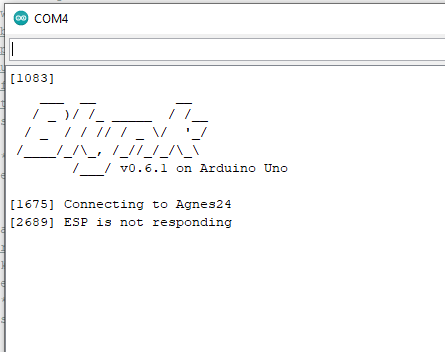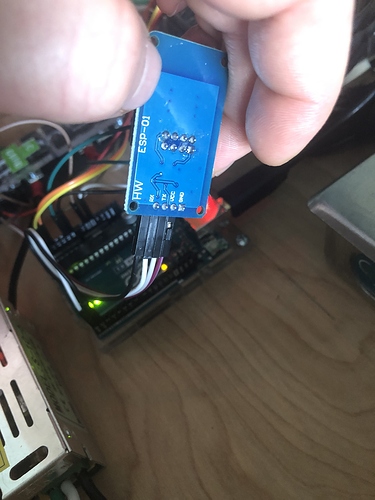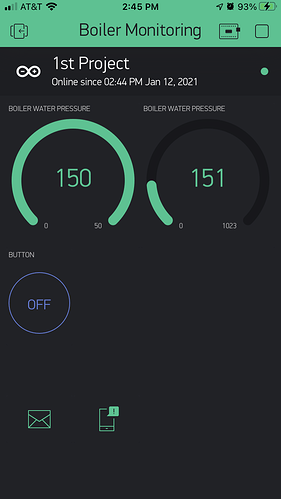I’m working on a project where the goal is to be able to monitor and shut down (if necessary) a hot water boiler using a PT100 rtd, a pressure sensor, and a conductance type low water level cutoff. I have an Arduino Uno, an i2C lcd, and an ESP8266. Initially I got the code working to just display onto the physical lcd hardware. I also verified with some simple code that the ESP8266 is working correctly and able to communicate with the Blynk app. All devices are externally powered, and do not draw on the Arduino source.
Next, I started integrating the code to work with Blynk so I can also monitor the values shown on the lcd on my phone as well. When I added the Blynk code, the lcd now stops showing anything, and continually reboots. Also, Blynk shows that the ESP8266 is continually going on and offline.
I looked all around the Blynk site and others to try to piece together a solution for this problem, but all examples appear to be just different enough to solve my specific problem. Also, I’m just learning how to code, so I’m learning as I go.
Any help in identifying where my code is problematic is greatly appreciated.
Thanks.
/*
The following functions are included within this program
Monitor P100 RTD
Reads an analog input on pin 0, converts it to voltage, and prints the result to a LCD Screen.
This example code is in the public domain.
http://www.arduino.cc/en/Tutorial/ReadAnalogVoltage
Monitor Pressure Transducer
Uses a standard 3-wire pressure transducer and reads the analog signal, then converts the signal to a
readable output and displays it onto a LCD screen.
Monitor Low Water
Using a GuradDog RB-24E conductance type low water cut-off switch, the device is powered by the
24V DC power supply. The 'pass-through' yellow leads of the device normally pass the 24V DC supply
through to the boiler to power it when the sensor senses water. In this case, the leads will be
connected to a 24V DC to 5V DC step down regulator. The regulator will normally supply 5V DC to the
Arduino when the RB-24E senses water. When the RB-24E does not sense water, the 5V supply will stop
supplying power to the Arduino. The Arduino will then signal a relay to interrupt the boiler
power supply.
Values are sent to Blynk App via ESP8266 WiFi Module
*/
#include <Wire.h> //includes outside library allowing communication over i2c devices
#include <LiquidCrystal_I2C.h> //includes outside library allowing interfacing with LCD screens
#include <math.h> //mathematical functions for manipulating floating-point numbers
#include <ESP8266_Lib.h> //ESP8266 interface library
#include <BlynkSimpleShieldEsp8266.h> //Blynk interface with ESP8266
//Blynk communication variables
#define ESP8266_Baud 115200 //constant to set baud rate for the ESP8266 module
#define BLYNK_PRINT Serial //redirects built-in status prints like ASCII logo and time stamped messages to serial monitor
//pressure measurement variables
float pressureInput = A1; //select the proper analog input pin for the 3-wire pressure transducer
const float pressureZero = 99.5; //analog reading of pressure transducer at 0 psi
const float pressureMax = 929.775; //analog reading of pressure transducer at 150 psi
const int pressureTransducerMaxPSI = 150; //maximum pressure rating of transducer being used.
float pressureValue = 0; //variable to store the pressure value calculated from analog value
//temperature measurement variables
float tempInput = A0; // select the proper analog input pin for the P100 RTD
const int tempMax = 1023; //analog reading of PT100 RTD at 572 deg F
const float tempVoltageMax = 5.0; //constant set to the maximum voltage reading of P100 RTD
const int tempMaxDeg = 392; //constant set to the maximum temperature reading of the transmitter in deg F
const int tempMinDeg = 0; //constant set to the minimum temperature reading of the transmitter in deg F
float tempValue = 0; //variable to store the temperature value calculated from analog value
float tempVoltage = 0; //variable to store the calculated voltage
float round_tempValue = 0; //variable to store rounded tempValue
//GuardDog RB-24E monitoring Variables
int voltageInput = A2; //select the proper analog input pin for 5V
//display variables
const int baudRate = 9600; //constant to set the baud rate for the serial monitor
const int sensorReadDelay = 1000; //constant integer to set the sensor read delay in milliseconds
const int pressDisplayDelay = 500; //constant integer to set the pressure status message read delay in milliseconds
const int tempDisplayDelay = 1500; //constant integer to set the temperature status message read delay in milliseconds
const int lwcoDisplayDelay = 2500; //constant integer to set the low water cut-off status message read delay in milliseconds
//digital output to control relay
const int digOutPin = 7; //Assigns the digital output pin beting used to actuate relay
//Blynk code to communicate with ESP8266 and Blynk app
char auth[] = ""; //auth code given by Blynk app
// Your WiFi credentials.
// Set password to "" for open networks.
char ssid[] = "";
char pass[] = "";
//use Software Serial on Uno, Nano...
#include <SoftwareSerial.h>
SoftwareSerial EspSerial(2, 3); // RX, TX
ESP8266 wifi(&Serial);
LiquidCrystal_I2C lcd(0x27, 20, 4); //sets the LCD I2C communication address: format(address, columns, rows)
BlynkTimer timer;
//function sends Arduino's up-time every second to Virtual Pin
//in app, Widget's reading frequency should be set to PUSH. This means that you define how often to send data to Blynk app
void myTimerEvent1()
{
Blynk.virtualWrite(V5, pressureValue);
}
void myTimerEvent2()
{
Blynk.virtualWrite(V6, tempVoltage);
}
void myTimerEvent3()
{
Blynk.virtualWrite(V7, round_tempValue);
}
void myTimerEvent4()
{
Blynk.virtualWrite(V8, voltageInput);
}
//the setup routine runs once when reset is pressed:
void setup()
{
Serial.begin(baudRate); //initializes serial communication at selected baud rate bits per second
delay(10);
lcd.init(); //initializes the LCD screen
lcd.init(); //initialized the LCD screen
lcd.backlight(); //initializes the LCD backlight
pinMode(digOutPin, OUTPUT); //the assigned pin will control the relay with an output
digitalWrite(digOutPin, HIGH); //relay will be activated interrupting power to boiler when pin is LOW
//Blynk code to communicate with ESP8266 and Blynk app
Serial.begin(ESP8266_Baud);
delay(10);
Blynk.begin(auth, wifi, ssid, pass);
//setup a function to be called every second
timer.setInterval(1000L, myTimerEvent1);
timer.setInterval(1000L, myTimerEvent2);
timer.setInterval(1000L, myTimerEvent3);
timer.setInterval(1000L, myTimerEvent4);
}
//the void loop routine runs over and over again forever:
void loop()
{
//the following applies only to monitoring the pressure transducer
pressureValue = analogRead(pressureInput); //reads value from the input pin and assigns a variable
pressureValue = ((pressureValue - pressureZero) * pressureTransducerMaxPSI) / (pressureMax - pressureZero); // conversion equation to convert analog reading to psi
Serial.print(pressureValue, 1); //prints value from previous line to serial
lcd.setCursor(0,2); //sets cursor to column 0, row 2
lcd.print("Press.: "); //prints label
lcd.print(pressureValue, 1); //prints pressure value to LCD screen, 1 digit on float
lcd.print(" psig"); //prints label after value
lcd.print(" "); //to clear the display after large values or negatives
delay(sensorReadDelay); //delay in milliseconds between read values
//the following logic changes display and controls relay based on pressure conditions
if (pressureValue >= 28) {
digitalWrite(digOutPin, LOW); //activates relay, interrupting power to boiler
lcd.setCursor(0,3);
lcd.print("Pressure Too High!! "); //prints label
delay(pressDisplayDelay);
}
else if (pressureValue <= 10) {
digitalWrite(digOutPin, LOW); //activates relay, interrupting power to boiler
lcd.setCursor(0,3);
lcd.print("Pressure Too Low!! "); //prints label
delay(pressDisplayDelay);
}
else {
lcd.setCursor(0,3);
lcd.print("System Press. Normal");
delay(pressDisplayDelay);
}
//the following applies only to monitoring the P100 RTD
tempValue = analogRead(tempInput); //reads value from the input pin and assigns a variable
tempVoltage = tempValue * (tempVoltageMax / tempMax); //calculated voltage
tempValue = (93.867 * ((tempValue * (tempVoltageMax / tempMax))) - 65.707) + 1.041; //converts the analog reading to deg F
round_tempValue = roundf(tempValue * 1000); //rounding to 3 decimal places
round_tempValue = round_tempValue / 1000;
Serial.print(tempValue, 1); //prints value from previous line to serial
lcd.setCursor(0,0); //sets cursor to column 0, row 0
lcd.print("Temp.: "); //prints label
lcd.print(round_tempValue, 0); //prints temperature value to LCD screen, 0 digits on float
lcd.print(" "); //prints space after value
lcd.print((char)223); //prints degree symbol after space
lcd.print("F"); //prints F after degree symbol
lcd.print(" "); //to clear display after large values or negatives
delay(sensorReadDelay); //delay in milliseconds between read values
Serial.print(tempVoltage, 1); //prints value from voltage calculation to serial
lcd.setCursor(0,1); //sets cursor to column 0, row 1
lcd.print("Temp.V.:"); //prints label
lcd.print(tempVoltage, 3); //prints voltage value to LCD screen, 3 digits on float
lcd.print(" volts"); //prints label after value
lcd.print(" "); //to clear display after large values or negatives
delay(sensorReadDelay); //delay in milliseconds between read values
//the following logic changes display and controls relay based on temperature conditions
if (tempValue >= 250) {
digitalWrite(digOutPin, LOW); //activates relay, interrupting power to boiler
lcd.setCursor(0,3);
lcd.print("Temp. Too High!! "); //prints label
delay(tempDisplayDelay);
}
else if (tempValue <= 45) {
lcd.setCursor(0,3);
lcd.print("Temp. Too Low!! "); //prints label
delay(tempDisplayDelay);
}
else {
lcd.setCursor(0,3);
lcd.print("System Temp. Normal ");
delay(tempDisplayDelay);
}
//the following applies only to monitoring the GuardDog RB-24E
if (voltageInput <= 1000) {
digitalWrite(digOutPin, LOW); //activates relay, interrupting power to boiler
lcd.setCursor(0,3);
lcd.print("LowH2OLvl Detected!!"); //prints label
delay(lwcoDisplayDelay);
}
else {
lcd.setCursor(0,3);
lcd.print("Water Level OK "); //prints label
delay(lwcoDisplayDelay);
}
//Blynk code to communicate with ESP8266 and Blynk app
Blynk.run(); //initiates Blynk
timer.run(); //initiates BlynkTimer
}



